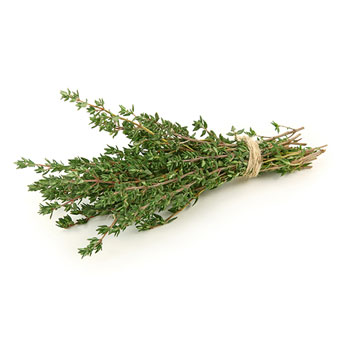Ghavami MB, Poorrastgoo F, Taghiloo B, Mohammadi J Journal of Arthropod Borne Disease, 2017 BACKGROUND: Fleas are important vectors of human and animal disease, and control measures for protection against their bites and flea-borne diseases are necessary. METHODS: The essential oils (EOs) of four native medicinal plants, Ziziphora tenuiore, Myrtus communis, Achillea wilhelmsii and Mentha piperita were isolated by hydrodistillation technique and analyzed… Read more »

- Botanical Name: Thymus vulgaris
- Alternative Names: Common Thyme
- Botanical Family: Lamiaceae
- Primary Constituent: Thymol
- Other Main Constituents: Para-cymene, Gamma-terpinene, Carvacrol
- Distillation Method: Steam Distillation
- Plant Part: Leaf
Anti-oxidant activity and major chemical component analyses of twenty-six commercially available essential oils
Wang HF, Yih KH, Yang CH, Huang KF Journal of Food and Drug Analysis, 2017 ABSTRACT: This study analyzed 26 commercially available essential oils and their major chemical components to determine their antioxidant activity levels by measuring their total phenolic content (TPC), reducing power (RP), β-carotene bleaching (BCB) activity, trolox equivalent antioxidant capacity (TEAC), and 1,1-diphenyl-2-picrylhydrazyl free… Read more »
Carvacrol-rich oregano oil and thymol-rich thyme red oil inhibit biofilm formation and the virulence of uropathogenic Escherichia coli
Lee JH, Kim YG, Lee J Journal of Applied Microbiology, 2017 AIMS: Urinary tract infections are caused primarily by uropathogenic Escherichia coli (UPEC), and indwelling catheters are usually colonized by UPEC biofilms tolerant to common antibiotics. Hence, UPEC biofilms pose a substantial challenge, and there is an urgent need for effective control strategies. METHODS AND… Read more »
Biological Activities of Three Essential Oils of the Lamiaceae Family
Nieto G Medicines (Basel), 2017 ABSTRACT: Herbs and spices have been used since ancient times to improve the sensory characteristics of food, to act as preservatives and for their nutritional and healthy properties. Herbs and spices are generally recognized as safe (GRAS) and are excellent substitutes for chemical additives. Essential oils are mixtures of volatile compounds obtained,… Read more »
Chemical Composition, Cytotoxic, Apoptotic and Antioxidant Activities of Main Commercial Essential Oils in Palestine: A Comparative Study
A Al-Tamimi M, Rastall B, M Abu-Reidah I Medicines (Basel), 2016 ABSTRACT: Background: Essential oils (EOs) are complex mixtures of several components gifted with a wide array of biological activities. The present research was designed to evaluate whether commercial essential oils could be effective by examining their in vitro antioxidant, cytotoxic, and apoptotic properties of nine commercially available EOs… Read more »
Antibacterial activity and interactions of plant essential oil combinations against Gram-positive and Gram-negative bacteria
Semeniuc CA, Pop CR, Rotar AM Journal of Food and Drug Analysis, 2017 ABSTRACT: The aim of this study was to compare the antibacterial effects of several essential oils (EOs) alone and in combination against different Gram-positive and Gram-negative bacteria associated with food products. Parsley, lovage, basil, and thyme EOs, as well as their mixtures (1:1, v/v),… Read more »
Enhancing blood donor skin disinfection using natural oils
Alabdullatif M, Boujezza I, Mekni M, Taha M, Kumaran D, Yi QL, Landoulsi A, Ramirez-Arcos S Transfusion, 2017 BACKGROUND: Effective donor skin disinfection is essential in preventing bacterial contamination of blood components with skin flora bacteria like Staphylococcus epidermidis. Cell aggregates of S. epidermidis (biofilms) are found on the skin and are resistant to the… Read more »
Susceptibility of herpes simplex virus type 1 to monoterpenes thymol, carvacrol, p-cymene and essential oils of Sinapis arvensis L., Lallemantia royleana Benth. and Pulicaria vulgaris Gaertn
Sharifi-Rad J, Salehi B, Schnitzler P, Ayatollahi SA, Kobarfard F, Fathi M, Eisazadeh M, Sharifi-Rad M Cellular and Molecular Biology, 2017 ABSTRACT: In recent years, with increased the prevalence of viral infections and having no specific for their treatment and also the continuous appearance of resistant viral strains, the finding of novel antiviral agents is… Read more »
Update on Monoterpenes as Antimicrobial Agents: A Particular Focus on p-Cymene
Marchese A, Arciola CR, Barbieri R, Silva AS, Nabavi SF, Tsetegho Sokeng AJ, Izadi M, Jafari NJ, Suntar I, Daglia M, Nabavi SM Materials, 2017 ABSTRACT: p-Cymene [1-methyl-4-(1-methylethyl)-benzene] is a monoterpene found in over 100 plant species used for medicine and food purposes. It shows a range of biological activity including antioxidant, anti-inflammatory, antinociceptive, anxiolytic, anticancer… Read more »
Microencapsulation of essential thyme oil by spray drying and its antimicrobial evaluation against Vibrio alginolyticus and Vibrio parahaemolyticus
Tomazelli O Júnior, Kuhn F, Padilha PJM, Vicente LRM, Costa SW, Boligon AA, Scapinello J, Nesi CN, Dal Magro J, Castellví SL Brazilian Journal of Biology, 2017 ABSTRACT: The aims of this research were first, to evaluate the antibacterial potential of commercial thyme essential oil against V. alginolyticus and V. parahaemolyticys and second, using the… Read more »
